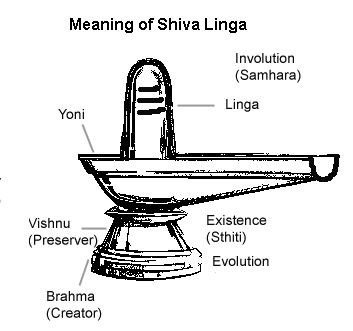Lord Shiva is worshipped in the form of linga from ancient times. Lord Shiva is one of the trinity of Brahma, Vishnu and Mahesh and even considered to be supreme lord. He has been worshipped by various devtas (gods) in Hindu mythology and by Vishnu Dashavatara’s. But why in the form of Linga?
Worship of Linga is not a strange thing and it is a known fact that reproductive organs have been worshipped across various civilizations. This underlines the importance of linga. By representing Lord Supreme, the humankind is suggesting to give proper importance to linga, hence Shiv linga is worshipped.
But Shivlinga is and should be treated as the manifestation of male and female and thus represent the birth of everything. Though Lord Shiva is also regarded as the god of destruction, an important aspect is forgotten that he is the beginning as well. Thus Lord Shiva is given the highest status symbolically and physically both.

Puranas and scriptures in Hinduism narrate in detail why Lord Shiva is worshipped in the form of linga. It is said that the he appeared before Lord Brahma and Vishnu in the form of a ‘pillar of fire’, which had no end and beginning. It is one among the many symbols of Brahman. There are numerous other incidents in the Puranas including the famous Deodar forest incident in which the wives of saints are attracted to Shiva and he castrates himself and leaves the Linga on earth as his symbol.
Incarnations of Lord Vishnu is known to have worshipped the Shivlinga including Lord Ram, Parashuram and Krishna.
When the mind is clear and is without prejudices, we will realize that the Linga form of Shiva is the most innocent form of Brahman that our ancestors had realized. It is pure and they got it from pure nature. Many of the forms that we worship today are the reflections of our mind, which is corrupted by ego, society and education. It is not pure.
As per the epic Mahabharata, ‘Know everything, which is male, to be Ishana, and all that is female to be Uma; for this whole world, animate and inanimate, is pervaded by these two bodies. Shiva’s divine Linga is worshipped by the Gods, seers, Gandharvas and Apsaras.’ (Chapter 7, section 20, verse 22)
The legend behind Shivlinga worship
Lord Shiva descended in form of Shivalinga on the day of mahashivaratri. Worshipping Shivalinga on the day of Mahashivaratri has different mythological significance and story. The story is as follows. Once, Prajapati Daksha organised a Yagya and invited all kings and deities, but, he did not call husband of Sati (Parvati). Knowing this, Sati burnt herself in the fire of this Yagya and died.
On the death of Mata Sati, lord Shiva became angry and started doing Tandav on earth in a naked form and started roaming on earth. Once, he reached the village of Brahmans. Brahmanis got fascinated by seeing this form of lord Shiva. On this, the Brahmans became angry and cursed him. As a result, lord Shiva’s Linga separated from his body and fell on earth. The weight of Linga was unbearable for earth. This incident created chaos in all the three Loks.
When the situation became worse, all god and Rishis reached lord Brahma for help. God Brahma came to knew the reason behind this incident. He went to lord Shiva with everyone. Lord Brahma worshipped Shiva and requested him to wear his Linga back. So, lord Shiva said that if everyone worship my linga then only he shall wore it back. On this, lord Brahma created a Shivlinga of gold and performed a systematic Puja. Later, all deities, Rishi, Muni created Shivlinga with different substance and worshipped it.
According to this legend, worshipping of Shivlinga had begun from that time. It is believed, a place where Shiva Linga is worshipped, changes into a pilgrimage. A person receives Shiva Lok if, he dies at a place where Shivlinga is worshipped always. Just by chanting the word ‘Shiva’, sins of a normal person are cancelled.